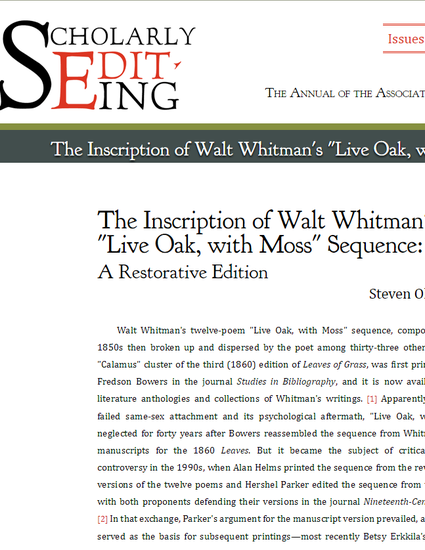
Article
The Inscription of Walt Whitman's "Live Oak, with Moss" Sequence: A Restorative Edition
Scholarly Editing
(2012)
Abstract
Walt Whitman's twelve-poem "Live Oak, with Moss" sequence, composed in the 1850s then broken up and dispersed by the poet among thirty-three other poems for the "Calamus" cluster of the third (1860) edition of Leaves of Grass, was first printed in 1953 by Fredson Bowers in the journal Studies in Bibliography, and it is now available in several literature anthologies and collections of Whitman's writings. [1] Apparently inspired by a failed same-sex attachment and its psychological aftermath, "Live Oak, with Moss" was neglected for forty years after Bowers reassembled the sequence from Whitman's surviving manuscripts for the 1860 Leaves. But it became the subject of critical adn editorial controversy in the 1990s, when Alan Helms printed the sequence from the revised "Calamus" versions of the twelve poems and Hershel Parker edited the sequence from the manuscript, with both proponents defending their versions in the journal Nineteenth-Century Literature. [2] In that exchange, Parker's argument for the manuscript version prevailed, and it has rightly served as the basis for subsequent printings—most recently Betsy Erkkila's version of the poems alongside photo-facsimile reproductions of the manuscript leaves (see note 1). Yet Erkkila's unqualified reference to the leaves as "clean and elegantly handwritten" (xii) typifies an ongoing failure by editors adequately to consider the state of the "Live Oak" manuscript. Whereas his initial inscription of this work can indeed be described as clean and elegant, Whitman's clear and present revisions to the leaves raise significant questions about the form of the sequence and his evolving intentions for its twelve poems. As I will demonstrate in this essay, Bowers's editorial focus on the final versions of the sundered manuscripts was not well suited for "Live Oak, with Moss," and the approach has resulted in the incorporation of changes that Whitman made to the poems after breaking the sequence apart. Along with detailing the transmission of the sequence in manuscript, this essay concludes with an edition of "Live Oak, with Moss" that restores the sequence to its original, integrated state. The restorative edition more accurately conveys the themes and intentions that inform "Live Oak, with Moss," and more clearly illustrates its significance in the development of Whitman's thought.
Keywords
- Walt Whitman,
- Live Oak,
- Calamus
Disciplines
Publication Date
2012
Citation Information
Steven Olsen-Smith. "The Inscription of Walt Whitman's "Live Oak, with Moss" Sequence: A Restorative Edition" Scholarly Editing Vol. 33 (2012) Available at: http://works.bepress.com/steven_olsen-smith/12/
